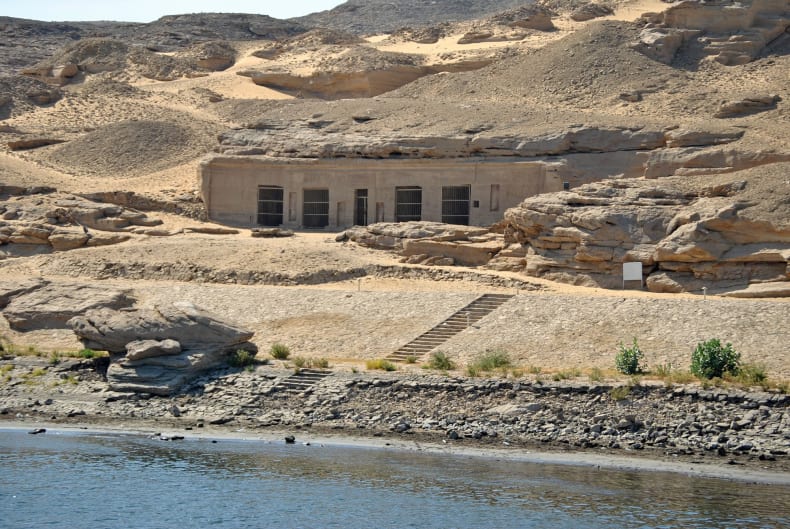Caminos' camp at Silsila in 1959
In 1955, Ricardo Augusto Caminos (1915-92) began surveying the rock-cut shrines at Gebel el-Silsila on behalf of the Egypt Exploration Society, a project that would last (on and off) until 1982. Originally from Buenos Aires, Argentina, Caminos pursued a career in Egyptology in the United States, Britain, and Russia. As well as his work at Silsila, Caminos is also known for his involvement in the UNESCO ‘International Campaign to Save the Monuments of Nubia’ during the construction of the Aswan High Dam, notably for his epigraphic copying of inscriptions at the sites of Buhen, Semna, Kumma, and Qasr Ibrim between 1960 and 1965.
While rehousing the Society’s collection of Beato studio photographs of Egypt dating to the late 19th century, staff recently (2019) came across a sealed package. It was slotted between a number of photographs and had likely not been spotted by researchers when consulting the material. Writing on the pack revealed that inside were to be found two paintings:
L. GREENER’S watercolours -
1. R.A.C.’s CAMP AT ABYDOS (1959)
2. R.A.C.’s CAMP AT SILSILAH (1959)
One of these paintings had been located some years previously in the personal papers of Caminos, though the subject and painter had remained unknown – until now. Fortunately, the second painting was still within the package and depicts the camp of Ricardo Caminos at Gebel el-Silsila on 9 February 1959.

The watercolour by Leslie Greener in the EES Lucy Gura Archive, depicting the camp of Ricardo Caminos at Gebel el-Silsila in 1959 (CAM.ART.03).
The Society’s annual reports indicate that between January and April 1959, Caminos was employed in recording the Speos of Horemheb at Silsila. This monument is shown on the left (west bank) of the painting, while the proximity of the Nile and the east bank can be seen to the right. The Nile and a felucca frame the escarpment looking north into the distance.

The Speos of Horemheb at Gebel el-Silsila in 2012. The bank has been built up and reinforced for smaller boats to moor up, allowing access for visitors, and the trees have gone. But the large boulder at the river bank in the painting is still visiable at the lower left of the photograph.
The artist, (Herbert) Leslie Standerwick Greener (1900-74), was probably working for the University of Chicago epigraphic mission in Luxor at the time and no doubt visited Caminos during the expedition season during which he likely painted this image. Crucially, no images of Caminos’ camp have survived in the EES Lucy Gura Archive and so this image is the first time we get a glimpse of how the team lived during their field season. The publication of this work was not completed when Caminos died in 1992, though the Silsila sub-archive remains a valuable resource for ongoing research and is regularly consulted by those currently working at the site as part of the Gebel el-Silsila Project.
This discovery, though small, just shows how much there is still to be found in archives and the historical importance of these paintings as well as their artistic beauty.
If you like this painting, then you can now purchase EES merchandise in our online shops at Society6 or RedBubble with this design.



